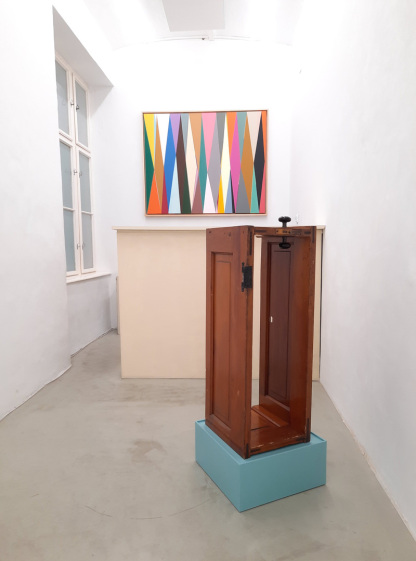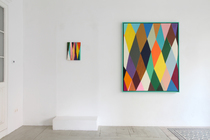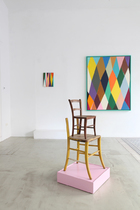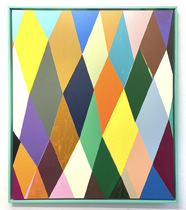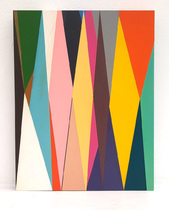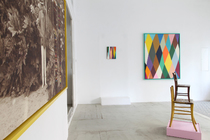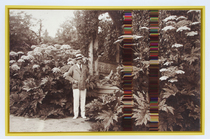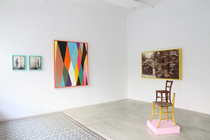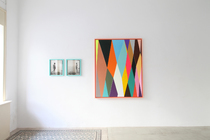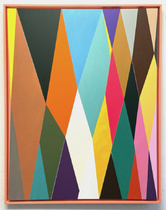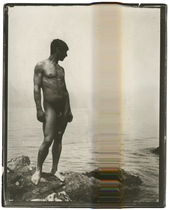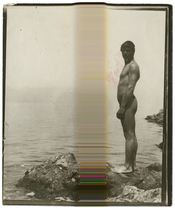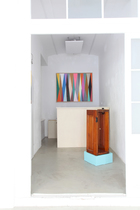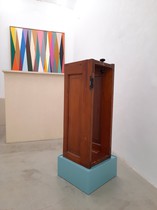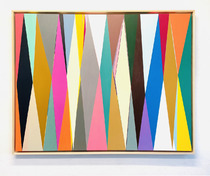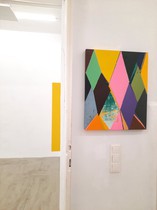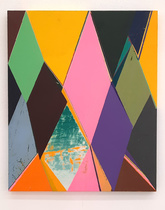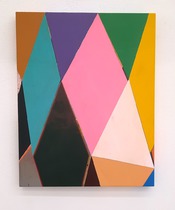25. Jänner - 3. März 2023
Michael Huey, Florian Nährer. Piggyback
Installation Shot: Michael Huey, Florian Nährer, Piggyback / Huckepack; Galerie Reinthaler, 2023. Photo: Gallery
Ungleich große Karos teilen die Bildfläche unter sich auf. Ungleich groß – und ungleich winkelig, gestaucht, gestreckt, verzerrt und
gekippt. Keine echten Rauten also. Keine echte Ordnung ebenso, und doch passt jedes Stück zu seinen Nachbarn. Zwischendrin blitzen manchmal schmale Keile auf, als ob sich die Struktur vom Objekt her
aufdrängen würde, nicht vom Maler, Florian Nährer. Als zersplitterte Einheit bedeckt die Farbe die Leinwand. Ihr Übergriff auf den Rahmen sprengt die Einheit der Bildfläche und untermauert die
Einheit des Werks.
Rauten füllen ein Rechteck nicht. Notwendigerweise bleiben Zwickel über. Entstehen seine Malereien von der Mitte oder den Rändern ausgehend? Die Antwort: Von der
Mitte her. Von der Mitte her entfaltet sich eine Struktur, wird auf-, wird aufeinander aufgebaut. Summand folgt Summand, doch das Ganze ist mehr als die Summe der Teile, und jeder Teil trägt das
Ganze als Bedingung und Möglichkeit mit. Ein Gelb trägt Violett, ein Pink Türkis, ein Orange Braun.
Irgendwo in den Spalten zwischen den Grenzen zweier Farben, diesen infradünnen Räumen, oder in den sich plötzlich auftuenden Tiefen eines Farbfelds, erwachsen aus
den Kompositionen Bilder. Oder eher: auf dem Weg des Lichts von der Fläche ins Auge, durch das Hirn ins Herz.
Ein alter Stuhl, mehr Hocker als Sessel, und darauf aufbauend ein zweiter. Die beiden ähneln sich sehr. Selbe Querstreben, selbe Sitzfläche, dieselben geschwungenen
Stützen. Echte Urtypen, bodenständig. Michael Huey ist auf der Straße darüber gestolpert. Plötzlich aufgetaucht wie eine verlorene Erinnerung.
Die Stühle bleiben, was sie waren, einfache Wirtshausstühle, Gebrauchsgegenstände, Stützen der Menschen, man könnte sagen: Prothesen. Sie wurden benützt und zeigen
die Spuren ihrer Verwendung. Sie sind Zeugnis ihrer Behandlung, manchmal Misshandlung. Lackschichten überdecken einander, brechen und reißen auf, ein paar Streben fehlen ganz. Ein pinkes Podest
verschafft dem Paar neuen Platz in der Welt. Sie sind nicht mehr nur, was sie waren, sie sind auch, was sie sind: Nicht mehr vergessen und nicht mehr nur ein Prädikat. In eine neue Ordnung
gebracht.
Ein zweiter Werkkomplex Michael Hueys speist sich aus Fotografien von Menschen, (diesmal) keine bestimmten. Eine Arbeit zeigt zwei Ansichten eines Nackten auf
felsigem Ufer, dahinter die weite See im Dunst. Das archaische Pathos wird gebrochen von Kopierstreifen, die die Schwelle des Illusionsraums erschüttern. Das Bild wird verletzlich. Der ursprüngliche
Mensch, erst von der Kamera zweigeteilt und in ein Abbild verwandelt, dann als Gegenstand verwahrt und gepflegt, schließlich reproduziert und neu beschrieben. Person ward Gegenstand ward Projektion.
Auch hier zeigt sich die Seinsweise einmal als Uroriginal, dann Prädikat, als Plural, Typus, dann wieder als singuläre Extension.
Doppel- und Dreifachnaturen, wie sie auch den Malereien inne liegt: ihr Bild-Sein ist auch ein Objekt-Sein, ihr Ganz-Sein ein Teil-Sein. Dazu die Kombination
greller mit gedeckten Farben, von vollen und Grautönen, planen Flächen und abfallender Räumlichkeit. Das Gleichgewicht zweier unvergleichlicher Größen wie Farbe und Form, oder Künstler und Künstler,
liegt in den Proportionen, nicht absoluten Werten. Die Gleichheit ist hier eine geometrische mehr denn eine arithmetische. Beim Huckepack wird Eins aus Zwei, und doch bleibt jedes Teil für sich
bestehen: „Piggyback“ mit Michael Huey und Florian Nährer in der Galerie Reinthaler.
Text: Victor Cos Ortega, Kunsthistoriker und Journalist
A checkered design of unequal proportions divides the image surface. The checks are of different sizes, with different angles; they are compressed, stretched, distorted and tilted. No real
diamonds, then. No real order either, and yet each piece fits its neighbors. Here and there, narrow wedges sometimes flash up, as if the structure were imposed by the object, not by the painter,
Florian Nährer. The paint covers the canvas as a fragmented entity. Its encroachment on the frame explodes the unity of the picture plane and underpins the unity of the work. Diamonds cannot
fill a rectangle. There must always be bits left over. Do his paintings originate from the center or the edges? The answer: from the center. From the center a structure unfolds, is built up, one
thing on top of another. Summand follows summand, but the whole is more than the sum of its parts, and each part carries the whole as condition and possibility. Yellow carries violet, pink carries
turquoise, orange carries brown.
Somewhere in the crevices between the borders of two colors, these infrathin spaces, or in the depths of a color field, suddenly breaking open, images grow out of the compositions. Or rather:
they ride the light from the surface into the eye, through the brain into the heart.
An old chair, more stool than armchair, with another one on top. The two are very similar. Same cross braces, same seat, same curved supports. True archetypes, down to earth.
Michael Huey stumbled across them on the street — surfacing suddenly, like a lost memory.
The chairs remain what they were, simple bar stools, utilitarian objects, supports for people, you could say prostheses. They have been used, and show the traces of their use. They bear witness
to their treatment, sometimes mistreatment. Layers of varnish cover them, breaking and cracking, a few struts are missing altogether. A pink pedestal gives the pair a new place in the world. They are
no longer just what they were, they are what they are: No longer forgotten and no longer just a predicate. Brought into a new order.
A second complex of Michael Huey's works draws on photographs of people, unspecified people (this time). One work shows two views of a naked man on a rocky shore, behind him the vast sea in a
haze. The archaic pathos is broken by copier stripes that unsettle the threshold of the illusionary space. The image becomes vulnerable. The original person, first split in two by the camera and
transformed into an image, then kept and cared for as an object, finally reproduced and newly described. A person became an object, which then became a projection. Here, too, the mode of being
manifests itself once as original, then predicate, as plural, type, then again as singular extension.
Double and triple natures, as is also inherent in the paintings: their image-being is also an object-being, their whole-being a part-being. Add to that the combination of bright and muted
colors, of full and gray tones, flat surfaces and sloping spatiality. The balance of two incomparable quantities like color and form, or artist and artist, lies in proportions, not absolute values.
The equality here is a geometric one more than an arithmetic one. In piggyback, two become one, and yet each part remains: "Piggyback" with Michael Huey and Florian Nährer at Galerie
Reinthaler.
Text: Victor Cos Ortega, art historian and publicist
UPCOMING:
TINA RIBARITS. Electric Entity
September 14 - October 25, 2024
VIENNACONTEMPORARY
Ulrike Königshofer, Tina Ribarits
September 12-15, 2024
NEW ADDRESS!
Getreidemarkt 14
A-1010 Wien / Austria
office[a]agnesreinthaler.com
Summer break till Sept 13, 2024
Open on appointment only
Sign up for the gallery newsletter
Please note that we are not accepting unsolicited artist submissions.
UID: ATU66256008
FN 357375b

